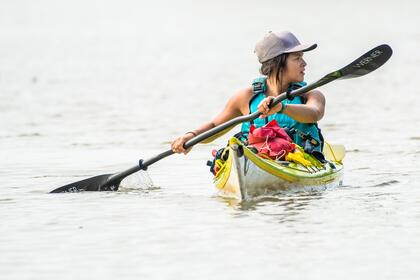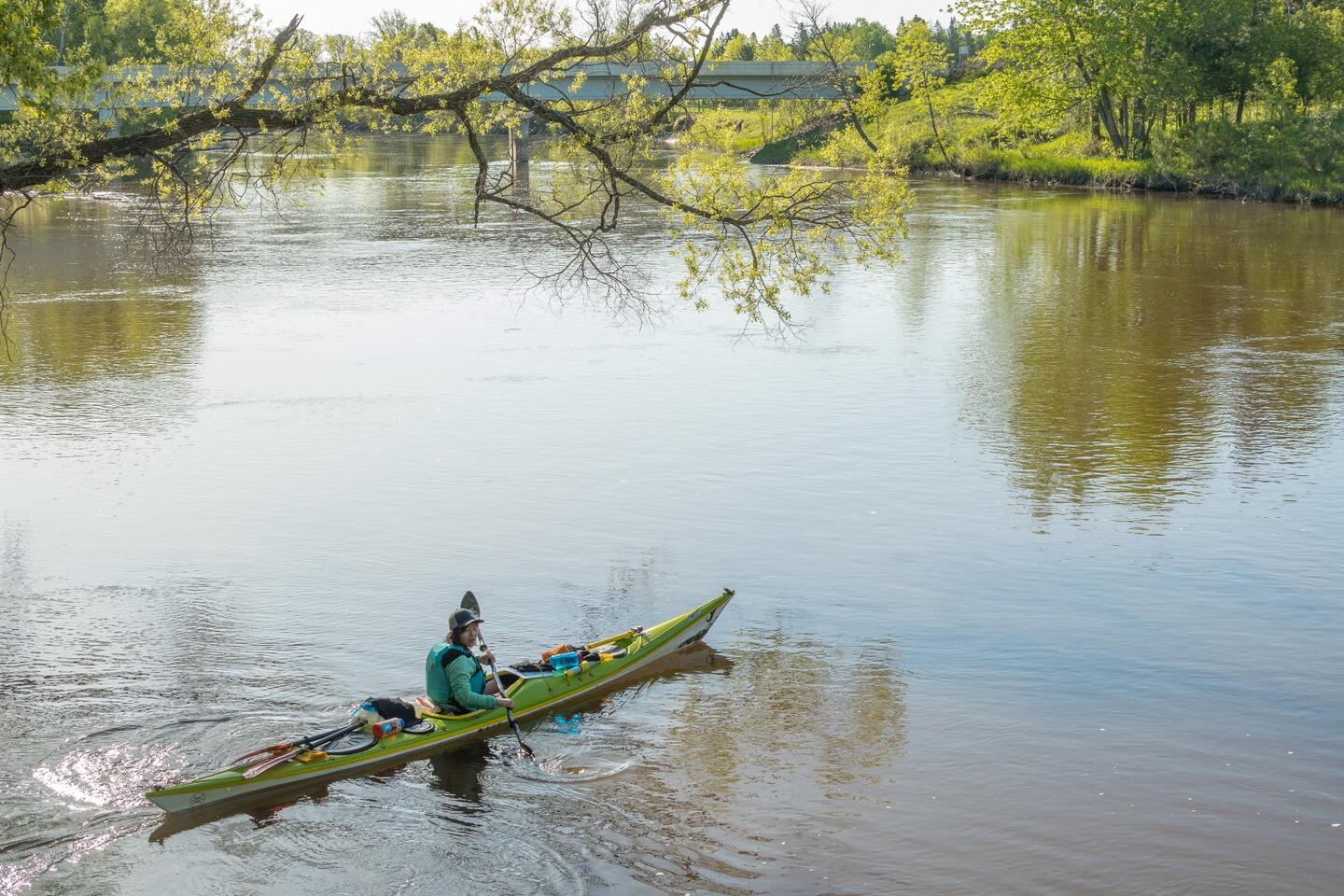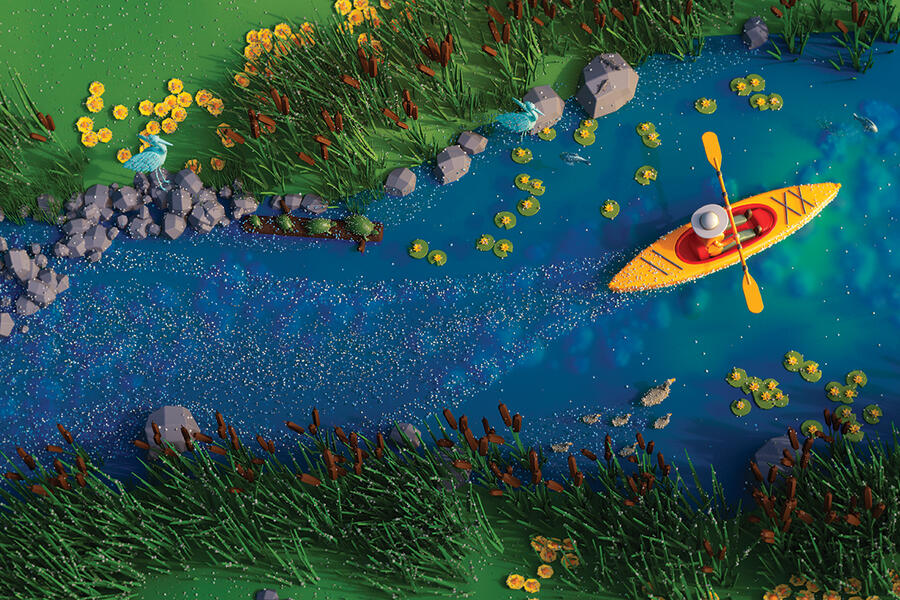Maya Dizack, BSPH '24 (ScM), parked her kayak under a tree and scrutinized the clouds. Dark and foreboding, they warned of a storm rolling in over the Louisiana bayou.
She debated whether to get off the river for safety's sake, having spent much of the last two months dodging storms as she paddled the length of the Mississippi, some 2,150-plus miles. Along the way she stopped 29 times to fill 65 one-liter bottles with surface water to study the concentration, distribution, and type of microplastics found in this mightiest of rivers.
She knew they were there but was eager to discover how many, and whether they were dispersed according to land use and population density. The answers—which would take years to uncover—surprised her and her advisers.
The excursion was part science, part adventure, and at times terrifying. As she watched the storm move in, a beautiful ibis, its white feathers flashing against the dark clouds, flew across her line of vision.

Image caption: Maya Dizack paddles the Mississippi River
Image credit: Michael McGuire
Literature is full of birds as omens, and this sure looked like one. Dizack doesn't believe in signs, but just in case she climbed ashore and took a break for lunch. "Then," she says, "out of the clear blue, lightning smote the tree I was paddling under. If I had been there, I probably would have been electrocuted."
Data and facts can get our attention. But science often needs storytelling to make us care. Dizack's thesis, "Microplastics in the Mississippi River: An Emerging Pollutant," fits within a growing body of troubling research into microplastics that is forcing scientists and environmentalists to sound the alarm about their findings.
How troubled we should be, and what we should do about it, is what researchers at Johns Hopkins and elsewhere are trying to figure out. The volume of microplastics research has exploded in recent years. Dizack's study was the first to take samples for the length of a river. Elsewhere at Johns Hopkins, public health professors are studying how to make ubiquitous plastic water pipes produce fewer microplastics, and Enid Neptune, a pulmonologist at the School of Medicine, is researching the long-term consequences of exposure.
We're just getting started here. Meanwhile, while you're reading this story, microplastics are raining down on us.
Microplastics are defined as a piece of plastic 5 mm or less in any dimension—the size of a pencil eraser down to a particle. Where do the pieces come from? Seemingly everywhere. And where do they end up? Seemingly everywhere. Degraded plastic products are found throughout the environment.
Dizack found microplastics at each of the 29 stops she made on the Mississippi. On top of a remote mountain in France, researchers found as many microplastics in the air as had been found in Paris. Microplastics have been found on glaciers, in birds on unpopulated islands, and in dolphins' exhales. Australian scientists estimated 9.25 million to 15.87 million tons of microplastics sit on the ocean floor.
Microplastics have been detected in fruits and vegetables, cosmetics, and household dust. They are in us, too—in our hearts, livers, kidneys, and more. Microplastics enter the food chain near the bottom and work their way up. Common sense says eating and breathing tiny pieces of plastic is bad for animals and for us. But we don't know how much is too much, or which microplastics are bad, worse, or harmless.
"A lot of these microplastics pass through us, but nanoparticles can pass through cell walls and get into organs and tissues," says Dave Love, a research professor at the Johns Hopkins Center for a Livable Future and one of Dizack's advisers.
As bad as that sounds, it isn't clear how serious the health risks are to humans. One study warned that microplastics "can interfere with important biological processes in the human body and can cause disruption of the endocrine and immune systems; can have a negative impact on mobility, reproduction, and development; and can cause carcinogenesis."
Although it isn't clear how bad microplastics are for humans, at least we know where they come from. Synthetic textiles (such as the polyester, nylon, spandex clothes we wear) produce microplastics by shedding particles when worn or used, washed, and dried.
Video credit: Encyclopaedia Britannica
If you go for a run, hike, or bike ride outside, your synthetic gear leaves wisps of microplastics in the environment. And it's no better if you wear that stuff only around the house. You throw your fleece in the washing machine, where it sheds particles too small to be caught by the filter. The particles enter the sewer system, evade filters at the water treatment plant, and wind up in the river. Or they get caught by the water treatment filters, get lumped in with human waste, and are sold as fertilizer, after which they are plopped onto a farm, blow away, and enter the environment that way.
And clothes are just one example. Plastic bottles, plastic bags, and plastic containers all erode, as do tires, road markings, marine coatings, and essentially every other plastic item. Even the pipes that bring us our drinking water bring us microplastics. But two Hopkins professors are working to stop that.
Hopkins chemist Howard Fairbrother has a long-standing interest in environmental issues. In his lab, much of his research has focused on studying carbon-containing materials. Since carbon is a main ingredient in all plastics, naturally he has studied microplastics, which emerged as a big environmental issue about 10 years ago and has accelerated since then.
"All the most desirable polymers that we use for plastic bags, for packaging, for toys, they are nonbiodegradable. They don't disappear. They have lifetimes of hundreds of thousands of years," he says. "When you discard them, when they enter the ocean or a landfill, slowly, over time, they start to break down."
One challenge is that when those big pieces of plastic break down into microplastics, they look an awful lot like naturally occurring carbon. "It's hard to distinguish one carbon from another," Fairbrother says.
Fairbrother and James Ranville, a chemistry professor at the Colorado School of Mines, came up with a fascinating way to examine the behavior of microplastics in laboratory studies by creating what essentially is a tracer and implanting it within the carbon.
They embed a small number of metal atoms into polymers. For researchers, that metal acts almost like a blinking light inside a resulting piece of microplastic. "You can find it and quantify it, even if it's present in a soup of other things, because the other stuff doesn't have the metal tag," Fairbrother says.
In collaboration with Carsten Prasse, a professor in the Department of Environmental Health and Engineering at Johns Hopkins, Fairbrother's research group is using plastics embedded with these metal tracers to study how plastic pipes used to transport drinking water release microplastics and other potentially toxic chemicals when they are exposed to disinfectants like bleach.
The scientists plan to study those microplastics—the rate, the size, where they go—to determine what circumstances cause microplastics to form and what circumstances don't. The goal of these studies is to make our drinking water safer.
"If we can figure out what are the polymer properties that eliminate or reduce the plastic production, we can say these are the kind of plastic properties you want to be focusing on," Fairbrother says.
The plastic properties Dizack focused on were fibers. They accounted for 97% of the pieces she found. That's because fibers float, and she gathered surface water.
What would she have found if she had sampled from 5 feet, 10 feet, 15 feet under the surface? That's one of many questions her study prompted that are ripe for future examination. And that's a common theme in microplastics pollution. Every study calls for more study. There's much we don't know about this emerging science.
"We are starting to learn more about the exposures side," says Love, who co-wrote the 2018 paper "Microplastics in Seafood and the Implications for Human Health." "We know a lot less about the human health risk. What does it mean for us? What does it mean for animals? That area needs more work."
Some of that work is being done at JHU.
Neptune, Yun Chen (an associate professor of mechanical engineering), and Chuan-Hsiang Bear Huang (an associate professor of pathology) are studying what happens in our lung pathways with long-term exposure to microplastics.
Early in the study of microplastics, researchers faced technological hurdles in detecting them. That problem has been solved, Neptune says. "The next phase is connecting the presence and the abundance of these materials to disease states," she says. "What I expect is that there are going to be more and more labs that will be working on different aspects of these exposures, such as whether they're a fiber as opposed to being a small particle. Does that make a difference?"
Dizack's thesis stands out amid a steady stream of microplastics studies, both for what she found and how she found it, her advisers say. It's one thing to say our water has microplastics in it. It's quite another to find those microplastics on an epic journey in which the intrepid scientist dodges ferocious thunderstorms, historic flooding, and a hurricane.
From the Twin Cities to Dubuque to St. Louis to Memphis and beyond, an estimated 17 million people live where she sampled. They love their river and care about how clean it is—or in this case, isn't. "The power of her study is the communication potential, connecting what's happening in your backyard to these bigger themes of planetary health," Love says.
Dizack conjured this river adventure while daydreaming during a human biology lecture at the University of Vermont, where she did her undergraduate work. Pondering her options for the summer, she thought she could work "at a camp and get paid very little or go work like a dog in a lab—and also get paid very little," she says. "Those are not very good options."
She wanted half of each—to be outside and do science. She recalled attending a symposium featuring an adventure blogger named Alyssum Pohl, who kayaked the Mississippi in 2015 to study plastic waste and water quality. What if she redid that?

Image credit: Michael McGuire
Dizack had more than a year to prepare before putting her kayak in the water in the spring of 2019—yes, more than five years ago. She talked to Pohl, gaining her blessing and advice. She lined up grants and persuaded a friend, fellow University of Vermont student and scientist Michael McGuire, to follow by car to help with resupplying and to document the trip.
She trained by intentionally flipping her kayak so that if that happened accidentally during the study, she'd able to right herself. In addition to the possibility of drowning, she also faced danger from barges, submerged trees, lightning, rain, wind, heat, floods, and Hurricane Barry, a Category 2 storm moving north from the Gulf of Mexico.
One night, as McGuire waited for Dizack in Louisiana, he shone his flashlight around the riverbank. Alligator eyes glowed back at him.
"The Mississippi was at flood stage, so she had to convince the dean and the associate dean that there was a safety plan in place that would make sure that she was not putting her own life at risk," says Kris Stepenuck, an extension associate professor at the University of Vermont who has been Dizack's adventure and science mentor since Dizack was 5. "It's questionable if that was really the case."
Stepenuck also served as an adviser on Dizack's thesis even though she works at a different university, a sign of how close they are. Dizack sheepishly admits now that she didn't always tell Stepenuck, whom she considers like an aunt, the full extent of the danger she faced. But Stepenuck knew because she followed Dizack with a GPS app and overlaid Dizack's location with the weather.
As a nod toward safety, Dizack turned off the Mississippi and onto the Atchafalaya River in Louisiana to avoid New Orleans and the abundant water traffic there. It's easy to imagine her pulling out of the water at the Gulf of Mexico, bounding into the lab, gleefully examining the water and exulting in what she discovered. But that's not what happened. The project stalled, like water behind a dam, for several years.
She hoped to send the water to be analyzed in early 2020. But COVID shut down labs. She kept the water in a 5-cubic-foot chest freezer she bought at Home Depot. Unsure what to do next, she relocated that freezer to her partner's parents' basement, and it stayed there even as she and her partner moved to Washington state.
"They held it over my head for years," she says. "I said, 'I will cook so many meals to make up for all the electricity I'm using. But please just let me leave them there for a little longer.'"
In 2022, she started working on her environmental health master's degree in JHU's Department of Environmental Health and Engineering, a cross-divisional program between the Bloomberg School of Public Health and the Whiting School of Engineering. She met with Ciaran Harman, an associate professor in Environmental Health and Engineering with a joint appointment in Earth and Planetary Sciences, about a research project. She mentioned, almost in passing, that she had paddled the Mississippi and collected water samples.
Could that be something? she asked.
In telling the story, Harman sounds like a baseball card collector asked if a Mickey Mantle rookie might be valuable. "Oh … my … God. Yes. … Yes. You should do this as your project. You've got all these samples, just waiting to be analyzed? This is a perfect project," he says.
Dizack searched for ways to coax from the eye-popping results a story a layperson could grasp. One idea was to calculate how many pieces of microplastics each of the 86 million people who live in the Mississippi River watershed contributed per day. Dizack's data-crunching unearthed a number so astounding Harman couldn't believe it: 302,000 per person per day. "I was like, 'that must be wrong,'" Harman says. "I got her to send me the spreadsheet, and I went through every line of her calculations.
"And it came out to 302,000."
Where do all those fibers come from? How do they get there?
"Is it just falling out of the atmosphere all the time?" Harman asks. "Are there point sources, like a fluff factory or something, that just spills a lot of microplastics into the environment?"
If that number was surprising, so was the dispersal behind it. Dizack thought she would see an increase in microplastics based on a change in land use—that forested areas would have fewer than farm and industrial areas. She even constructed her inquiry based on that theory. She tested every 50 miles for the first 600 miles, and every 100 after that. She thought that more frequent testing would allow her to trace the increase in microplastics as the land use changed from forest to farming to industrial.
But that didn't happen. She found no relationship between the number of microplastics and land use.
The story's not over, of course.
Fairbrother says many polymer chemists are now working to figure out a way to do "depolymerization"—that is, to turn a polymer back into the monomer it started out as. If this can be accomplished, "you go back to the starting material and make something new," he says. "You can reuse the trash."
The consensus among experts is that one key to decreasing microplastics is changing our behavior—never an easy sell. What can an individual do? You can buy clothes (and other products) that biodegrade. You can buy special filters for your laundry. "Individual actions like buying products without plastic packaging or picking up litter are helpful," Love says. "But we also need government policies that create systemic changes."
Dizack works now as a research associate for the Johns Hopkins Center for Indigenous Health as part of the Diné Household Water Survey, focusing on water access for the Navajo Nation.
For Dizack, the danger and long days of paddling made collecting the water portion of the project exhausting. The tedium of the lab work was exhausting, too. "I'm pretty done with hearing the word 'microplastics' at this point," she says. "I feel triggered when I hear it in the news."
She's joking, sorta, mostly. Evidence of microplastics in the environment is so well established that she has no interest in, say, kayaking the Potomac to collect water samples.
She'd rather work on helping people who are exposed to them. When she looks around the next bend of the proverbial river, she can imagine herself working on that. "How do we monitor microplastic exposure in humans? What diseases might be associated with those plastics? That is definitely of interest to me," she says. "But we're probably five to seven years away from that work because the methods just aren't there."
When those methods are agreed upon, that work will be full of challenges, chief among them being to discern what problems are caused by microplastics and what existing problems are made worse by them. But if Dizack's Mississippi adventure proved anything, it's that she is prepared to face challenges.
"I want to do things that have an actionable end," she says.








